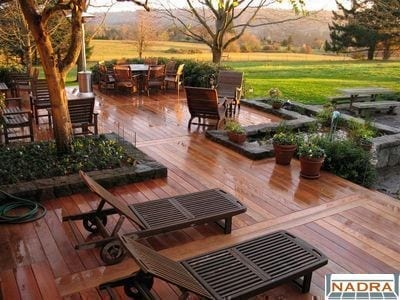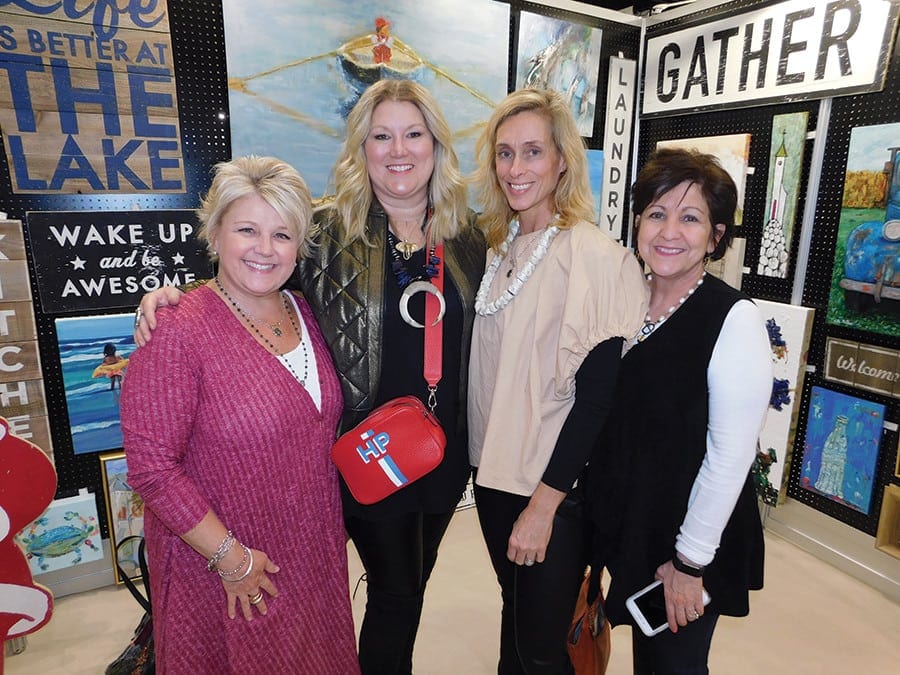Making the Most of Your Outdoor Space

You might not initially think of hardscaping as the “coolest” part of your yard to makeover. Splashy furniture paint and garden beds full of flowers seem much more fun and rewarding.
But in reality, hardscapes actually make a huge impact on your yard and can turn a Plain Jane house into the rock star of the block. Go all out and start adding outdoor rooms, fireplaces, pools and fire pits…and pretty soon your home feels more like a year-round vacation spot.
Planning is Indispensable
Regardless of what hardscape you choose to work on – driveways, walkways, retaining walls, fountains, pools and patios – the first step is to obtain a boundary survey. This important element reveals the location of sewers, storm drains and property lines and is the pathway to a building permit.
“I’m an outdoor space planner,” says Eric King of King Landscaping. “I look at the exterior like an interior designer looks at room planning, and even if the homeowner wants a simple project, I still draft a comprehensive design that fits the client’s home and lifestyle. ”
“Even driveways and walkways need aesthetics,” says King. “Everything in the landscape should make the house look beautiful, especially the sidewalk leading up to the house. The front door should be the focal point.”
David and Tina Jacobson of Sandy Springs agree. “The addition that has made the most difference (to the way you see our house) is the sidewalk leading to the front door,” says Tina.
“The front of your house usually calls for upscale materials, but in the backyard, placement should determine the material,” says King. “Other than a pool, a patio is the primary hardscape in the backyard. The closer to the house, the more often it will be used. I advise clients to spend the most money on walkways leading to their patios and to use mulch or a crushed stone path in the natural areas.”
The Jacobson family followed King’s advice by beginning with a new walkway leading to circular paver patio in the back. “We liked it so much we called him for Phase II, the front sidewalk and landscaping. In Phase III he revamped the backyard and made it seem so much bigger.”
And when it comes to driveways, King likes to deemphasize them by mixing gray or brown throughout the concrete. This way, it blends better with the landscape. “Despite upping the price from $1 to $1.50 per square foot, natural colors are a better choice. They look far better than gleaming white concrete that draws the eye away from the entry,” says King.
Landscape Improvements
It’s hard to look at a friend’s beautiful stone waterfall or pond and hear its soothing music without experiencing pangs of jealousy. Fortunately, landscape features like these are well within the grasp of most homeowners. Pergolas, stone planting beds, benches and stone sculptures are all affordable if completed in stages and add great value to a home.
While traditional designs call for stepping-stone paths, stacked stone planter walls, and wide porches and stairs, a contemporary home may look best paired with square stones or pavers. Brad Renkin of Hearthstone Environments explains: “Contemporary pools and fireplaces can be constructed using sleek materials like limestone, bluestone, manufactured stone or concrete, while natural chipped flag stones or bricks may work better for traditional homes. If you stick to the basic principles of design, you can’t go wrong.
“Regardless of style, compatible materials must be used throughout the yard to integrate the features,” he says. “Utility features like driveways can be dressed up using exposed aggregate where the stones are visible in the concrete.”
When it comes to your budget, first review all your material options. The least costly driveway material is concrete, which runs $4.00 to $7.00 per square foot, followed by a stamped pattern. Aggregate can run up to $12 per square foot, and a stone apron can add an additional $3,000.
Family Fun
“We’ve installed waterfalls, pools, fireplaces, fire pits and outdoor kitchens,” says Renkin. “We’re also working with CBA Sports to add tennis, basketball and volleyball courts. I’m dying to build a hybrid pool and patio combination like Olympic Park. When the water is off, it’s a patio. Turn it on and you have an instant splash party.” (Note: pricing of these features varies greatly, so homeowners should get several estimates before embarking on such a project.)
But buyer beware. Currently, Georgia does not require swimming pool contractors to hold licenses, so homeowners need to make sure their contractor has a certificate from the Association of Pool Spa Professionals (APSP) and have liability insurance and workman’s compensation. “Customers should ask to see examples of a contractor’s work and visit his projects,” says Renkin. “It’s hard to tell from a picture if stone work is good or bad. It’s much easier to see in person.”
Variety is the spice of life
“Bricks have been around forever and are equally attractive in traditional and contemporary homes,” says Rick Sherman of Sherman’s Masonry whose family-operated company has been in business for 15 years. “There is no down side to bricks. They work well for walkways, retaining walls, fireplaces, benches, sitting areas, and fire pits.” However, while brick accents on a driveway can add curb appeal, one made entirely of bricks can be difficult to maintain.
Sherman, who works with landscape architects and directly with homeowners, says, “Specify Type S or higher mortar if the project is not protected by the home’s eaves. The higher strength helps fight off freeze-thaw issues and will lengthen the life and enjoyment of the project.
Alternatives
Today, many attractive but less expensive materials are available that have the durability of stone but are easier to install. “You can go for the look of cobblestones which conjures up images of quaint small towns or choose a much more contemporary look by using large-scale pavers,” says Ken O’Neill of Oldcastle Architectural – Belgard Pavers.
Interlocking pavers are made to be durable, but like most products, are best installed by licensed contractors who consider surface requirements, O’Neill explains. “Avoid laying pavers over an existing concrete surface and consider drainage and other issues that can impact performance.” Oldcastle offers a lifetime guarantee and will replace broken pavers, even for subsequent homeowners.
As for style, “don’t be afraid to ‘paint’ with pavers and choose colors that make an impact but also work with your home environment,” O’Neill says. “Light colors open up an area, whereas darker tones make areas appear smaller.” Multicolored pavers blend in with their surroundings and minor stains are camouflaged in the array of tones.
Another manmade alternative is the VERSA-LOK retaining wall system, which is cost effective and easy to install for do-it-yourselfers. The system makes installation nearly foolproof because there are no voids to fill with mortar and the plans can be modified on site.
No matter which material you choose, making your outdoor space more functional just makes sense with a moderate climate like ours. By starting with small, but impactful features and doing projects in phases, your outdoor spaces can become the center of family life.
7 costly mistakes to avoid
1. Obtain a boundary survey to make sure the natural flow of water is not disturbed.
2. Be sure your landscaper has a permit.
3. Get a complete landscape design, even if you plan to begin with a small project.
4. Interview and choose a well-established designer, as well as an installer. (They may be one and the same).
5. Keep in mind that you can only cover 30 to 50 percent of the lot with hardscapes.
6. Function should determine the material choice.
7. Choose your patio furniture before construction begins. This way, you can make sure its large enough to accommodate all the pieces.
Know Your Hardscape Materials
Eric King of King Landscaping put together this handy primer on what hardscapes are appropriate
for your budget and your needs.
 |
Concrete
Cost: $4-$6 per sq. ft. or $7-$10 per sq. ft. for integrated color throughout the concrete, exposed aggregate and stamped patterns.
Good for: Utilitarian purposes like driveways or walkways to unseen areas like a basement door or tool shed.
Not recommended for: Front walkways, high visibility patios, and retaining walls.
 |
Bricks or prefabricated concrete pavers
Cost: $10-$16 per sq. ft.
Good for: Walkways, patios, trim, retaining walls (Brick retaining wall: $18-$25 per sq. ft.)
Not recommended for: Entire driveways, due to high cost and maintenance issues.
 |
Natural stone, irregular flagstone or cut stone
Cost: $18-$24 per sq. ft.
Good for: High visibility areas like front and patio walkways, patios, driveway aprons, fire pits, fireplaces, outdoor kitchens, retaining walls.
Not recommended for: Use on an entire driveway, due to cost.
 |
Modular blocks
Cost: $16-$24 per sq. ft.
Good for: Retaining walls. Relatively easy to install, allow for water to flow through and cheaper than mortared stone.
Not recommended for: Driveways, walkways, highly visible decorative use. More functional than aesthecially pleasing.
Note: Additional costs may apply because every yard or project is unique due to access, grade and size.[embed:fc:field_portfolio:1287:fc_portfolio_node_embed]

The Case for Proper Home Maintenance

Out and About Mixing and Mingling with Industry Pros

Take a tour of Grant Park on October 22

Award-Winning Kitchens, Baths, Interior Design and More

Atlanta’s NKBA Designs of Distinction 2019 Winners

100 Things to Know Before You Remodel

What’s the simplest way to upgrade your window treatments?







